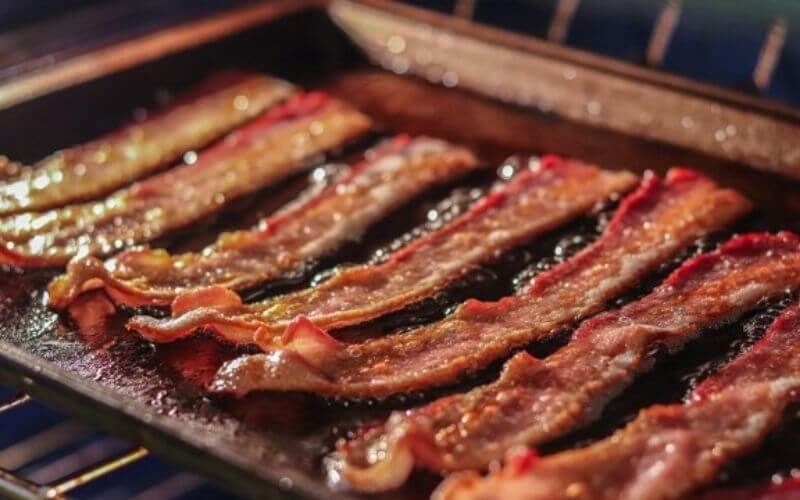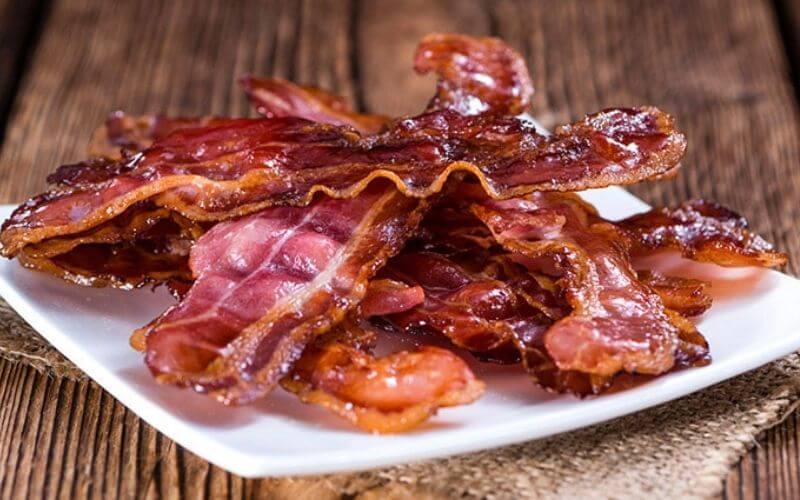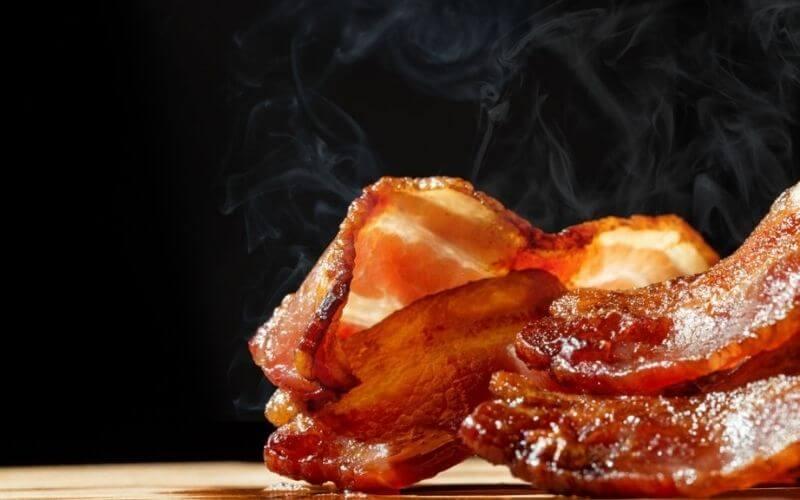Hate cooking bacon on the stove? Few people fry bacon on a pan and get away unscathed; there are oil splatters and burns and most folks huddle behind their counter to avoid bacon-related injuries.
Since no one is giving up bacon any time soon, we decided to come up with an alternative. Something that reduces the chances of oil splatter burns and chewy bacon. You use this method to cook up a batch of bacon easily when you have guests over or fancy up your breakfasts.
Yup, we’re talking about grilling bacon. If you’re wondering, ‘Can you grill bacon?’ The answer is a resounding yes. Bacon can be grilled for a nice juicy and smoky flavor, with the perfect crispy texture.
If this seems a little over-the-top, stay with us a minute. We will show you how to cook bacon on the grill for unbelievable results and easy cleanup. As a bonus, we will also show you how to cook bacon in a skillet, as well as on a griddle without all the trouble.
Cooking Bacon on the Grill

Grilling bacon may be the easiest way to cook bacon. You don’t have to deal with scary grease splattering on your arms, cleanup is easy and the grilling gives an amazing depth of flavor.
What You Need:
- Outdoor grill
- Aluminum foil
- Bacon
Directions:
1. Put out a double sheet of foil, measured to hold the amount of bacon you want to grill, with the edges turned up to collect the bacon fat.
2. Place the foil on a sheet pan or baking tray.
3. Preheat your grill to medium heat (350F-400F).
4. Place your bacon strips on the foil, making sure they aren’t overlapping.
5. Place the baking sheet on the grill grate and close the lid.
6. Cook for 12 minutes or until it reaches your desired level of crunchiness.
7. Transfer bacon to a plate lined with paper towels to absorb extra grease.
Frying Bacon on the Stove
On a Griddle:
Cooking bacon on the griddle, electric, or otherwise is a good option because the bacon can be laid down flat, which also makes them easier to flip.
That’s not all. Griddles allow you to cook in bulk, and also makes it easy to drain the grease that is rendered from the bacon.
Directions:
1. Take the bacon out from the fridge at least 15 minutes before cooking.
2. Place each strip onto a cold electric griddle. Make sure none of the strips are overlapping while fitting as many as possible.
3. Turn the griddle up to 325F. This is the ideal temp to cook bacon on griddles.
4. Flip the bacon just once. To check if they need flipping, use tongs to lift a piece slightly and peek under it. If it has browned, turn it over.
5. The second side doesn’t need as long to cook, so wait a minute or two before killing the heat.
6. Once the bacon is done, transfer to a plate lined with paper towels to absorb the excess fat.
In a Fry Pan or Skillet:
Although it is the scariest way, it is also the most common way of cooking bacon on the stove. Here’s the best way to fry bacon without any trouble.
Directions:
1. Start with a cold pan or skillet. Bacon should always start off in a cold pan, so lay out your strips on the pan before turning on the flame. It’s okay to crowd the pan, but try to keep the overlapping to a minimum.
2. Cook the bacon low and slow. Turn your burner on low and slowly cook the bacon. The bacon will soon start to release some of the fat. When the strips start to curl up, use tongs to loosen the strips and turn them over.
3. Keep flipping and turning the bacon strips so that they all brown evenly.
4. Pour off grease carefully. The easiest way to do this is to spoon them off. If you want to pour off the grease, make sure the flame is off and the container you are draining the grease into is heat-proof.
5. Fry until the bacon is done. This will depend on how crispy and browned you like your bacon.
6. Remove the cooked bacon from the pan and let the extra oil drain off on pieces of paper towels.
Crispy Bacon or Chewy Bacon?

People often debate over the superior sort of bacon. Some love their bacon with a good crunchy texture, while others prefer a softer and chewier slice.
The difference lies in the way the bacon is cooked, and also in the amount of fat in your strips. In crispy bacon, the fat is rendered out completely, giving you a drier texture. On the other hand, chewy bacon contains some of the fat, giving it a moist and meaty mouthfeel.
To make your bacon on the crunchy side, cook the bacon on low heat slowly. This will gradually melt out the fat, giving you that crispy texture. The longer cook time also makes the meat less tender, giving it the signature crunch.
To make chewy bacon, cook the strips at a hotter temperature for a shorter time. A hotter pan will cook the bacon before the fat has the chance to melt out. As a result, the texture will be softer, with chunks of fat.
No matter how you like your bacon, both crispy and chewy strips make for a hearty breakfast of the champions. If you want to experiment, pairing crispy bacon with eggs and chewy ones with pancakes is a great way for both sorts of bacon.
Bacon Cooking Tips
Follow these tips for diner-style bacon that will taste like it was made by a chef!
- Always start bacon in a cold pan.
- Drain your bacon afterward to stop them from going soggy or being overly greasy.
- Wear oven mitts to prevent oil splatter when cooking bacon on a griddle or fry pan.
- Cook over medium heat, as bacon can burn quickly.
- Put a little water onto the frypan. This renders the fat, reduces splatter, and results in crispy edges every time.
- Cook them in the microwave by stacking the bacon on layers of paper towels on a plate. When cooked for 4-6 minutes, the bacon will be done with little cleanup involved!
Frequently Asked Questions
Below you will find answers to questions people often have about cooking bacon.
01. What is the Best Temperature to Cook Bacon?
When grilling or baking bacon, 400F is the best temperature to cook it on. When cooking on a stove, using medium-low heat is the best way to prevent burning or overcooking.
02. Can I Use a Cast Iron Skillet to Cook Bacon?
Using a well-seasoned skillet is perhaps the best way to cook bacon. You will get crispy edges, and be able to spoon out the extra fat with ease. It renders out the fat quickly, giving your bacon an evenly browned surface.
03. Which is Better- Grilling or Frying Bacon?
Grilling bacon results in no oil splatter. It is also a hands-free process and needs minimal cleanup. Best of all, it reduces the amount of shrinkage of your bacon, so there is more to munch on!
04. Can I Add Seasoning to My Bacon?
You can season your bacon with any herbs and spices of your choice. For a more interesting flavor, sprinkle some brown sugar onto the strips.
This will caramelize and add a complex sweetness to the typical bacon flavor. You can even brush on some maple syrup to glaze your bacon.
05. How Can I Bake Bacon Properly?
Put a rack in the center of a large sheet pan. Place the bacon on top of the rack so they are evenly spaced out and aren’t overlapping.
Bake at 375°F for 15 minutes, then carefully turn over and bake further until the bacon is fully cooked; golden-brown in color and crisp. This can take around 8 to 10 minutes depending on the thickness of the bacon slices.
So the Point is..
Salty, smoky, meaty. Bacon is the one food that can unite half the world and cure their woes. Whether you like it crispy or chewy, no hearty breakfast is complete without bacon.
This article shows you how to cook bacon in 3 ways. Knowing how to cook bacon on a grill is the easiest and safest way to get perfectly crispy bacon.
The next time you are having a backyard BBQ, grill up some bacon as an appetizer, or for guests to nibble on along with their sides. You’ll be surprised at how much more bacon you can fit into your meals when you aren’t worried about the cooking process!
So fire up your grill and start laying out your bacon!
